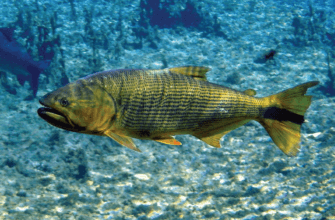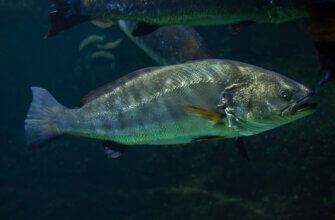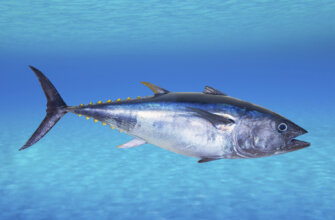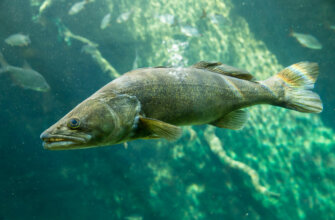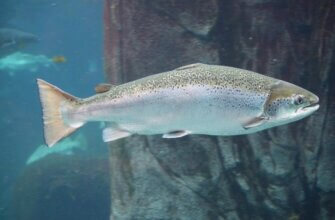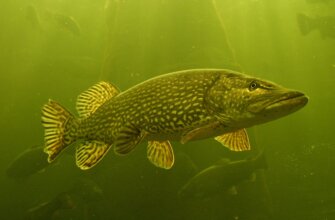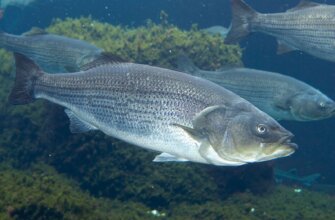The Traira, also known as the Wolf Fish or Hoplias malabaricus, is a species of predatory freshwater fish that is found in South America. It is a popular game fish and is highly sought after by anglers due to its aggressive nature and hard fighting ability.
Traira are typically olive green in color with a white underbelly and dark spots along their sides. They have a long, cylindrical body with a large mouth and sharp teeth.
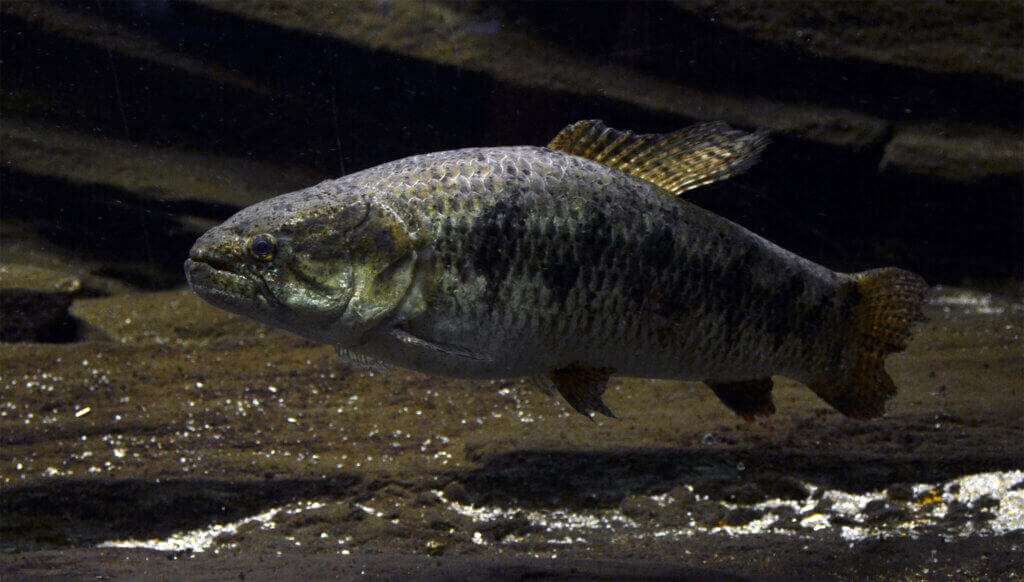
Traira are primarily carnivorous and feed on a variety of prey including fish, frogs, and small mammals. They are known for their ability to ambush their prey from hiding places in the water and are often found in shallow areas near vegetation or structure.
In terms of behavior, Traira are known for their aggressive nature and can be quite territorial. They are also known to jump out of the water when hooked, making them a popular target for fly fishermen.
Overall, the Traira is a fascinating and popular game fish that offers a fun and challenging fishing experience for anglers.
Species
“Traira” is the common name for several species of freshwater fish belonging to the family Erythrinidae, which are found in South America. The most commonly known species of traira is Hoplias malabaricus, also known as the wolf fish or tiger fish. It is a popular game fish among anglers in South America due to its aggressive behavior and fighting ability.
Other species of traira include Hoplias lacerdae, Hoplias microlepis, Hoplias aimara, and Hoplias australis. These fish are typically found in rivers, streams, and other freshwater habitats in South America and are known for their carnivorous diet, feeding on other fish, insects, and crustaceans.
In addition to their popularity as a game fish, some species of traira are also consumed as food by local populations in South America.
Appearance
The traira, specifically referring to the Hoplias malabaricus species, has a distinct appearance.
Here are some characteristics:
- Body Shape. They have an elongated and cylindrical body shape, somewhat resembling a torpedo. The body tapers towards the caudal fin.
- Coloration. Traira typically have a greenish to olive-brown coloration on their upper body, which helps them blend in with their surroundings. The belly is lighter, often yellowish or white.
- Scales and Skin. Their body is covered in large, cycloid scales that provide protection. The skin may have a slightly rough texture.
- Head. Traira have a large, broad head with a slightly flattened profile. The mouth is equipped with sharp teeth, including prominent canine-like teeth in the front.
- Fins. They have two dorsal fins, with the first dorsal fin being relatively high and elongated. The pectoral and pelvic fins are also well-developed.
Overall, the traira has a predatory appearance, with its sharp teeth and streamlined body shape, indicating its adaptation for hunting and capturing prey. It is worth noting that the appearance may vary slightly between different species of traira, but the general characteristics described above apply to the commonly known Hoplias malabaricus.
Size and weight

The size and weight of traira (Hoplias malabaricus) can vary depending on factors such as age, habitat, and availability of food.
Here are some details regarding their size and weight:
- Length. Traira can reach lengths of up to 3 feet (90 centimeters) or even more. However, most individuals caught by anglers are usually between 1 to 2 feet (30 to 60 centimeters) in length.
- Weight. The weight of traira is highly variable. Juveniles and smaller individuals typically weigh a few pounds, while larger adults can weigh anywhere from 5 to 15 pounds (2 to 7 kilograms) or more.
- Growth Rate. Traira grow relatively fast, especially during their first few years of life. With abundant food resources, they can reach lengths of around 1 foot (30 centimeters) within their first year.
It’s important to note that the size and weight of traira can differ based on the specific geographic location and environmental conditions where they are found. Populations living in nutrient-rich habitats or large bodies of water with abundant prey tend to grow larger compared to those in less favorable conditions.
Additionally, it’s worth mentioning that the size and weight mentioned here are general estimates and individual traira can deviate from these averages. Anglers often prize catching larger traira due to their challenging fight and impressive size.
Diet
Traira (Hoplias malabaricus) are carnivorous fish with a diet that primarily consists of other fish, but they also consume a variety of other prey items.
Here are some details regarding their diet:
- Fish. Fish make up a significant portion of the traira’s diet. They are opportunistic predators and will feed on a variety of fish species, including smaller individuals of their own kind, as well as other species such as characins, cichlids, and catfish.
- Invertebrates. Traira also prey on a range of invertebrates. This can include insects like aquatic beetles, grasshoppers, and dragonfly larvae. They may also feed on crustaceans, such as crabs and shrimp, when available.
- Amphibians and Reptiles. Traira are known to consume amphibians and reptiles, including frogs, tadpoles, and small snakes that venture into the water.
- Small Mammals and Birds. On rare occasions, traira have been reported to prey on small mammals, such as rodents, and even small birds that may come close to the water’s edge.
- Opportunistic Feeding. Traira are known for their opportunistic feeding behavior, meaning they will take advantage of any available food source. They are known to scavenge on carrion and may even consume plant material in small amounts.
It’s important to note that the diet of traira can vary based on their size, habitat, and local prey availability. Juvenile traira may feed on smaller fish, insects, and crustaceans, while larger adults tend to target larger prey items such as fish and amphibians. Their ability to adapt their diet to available food sources contributes to their survival in different ecosystems.
Behavior
Traira (Hoplias malabaricus) exhibit several behavioral characteristics that contribute to their survival and predatory nature.
Here are some details regarding their behavior:
- Aggression and Predatory Nature. Traira are known for their aggressive and predatory behavior. They are opportunistic hunters and actively pursue and ambush their prey. They use their sharp teeth and powerful jaws to capture and consume their food.
- Solitary Predators. Traira are primarily solitary fish, often found hunting alone rather than in groups or schools. This behavior allows them to have a larger hunting range and reduces competition for resources.
- Ambush Predators. Traira are adept at ambushing their prey. They often hide among vegetation, submerged logs, or other structures in the water, waiting for unsuspecting prey to swim close. They swiftly strike and capture their prey using their quick bursts of speed.
- Nocturnal Activity. Traira are known to be more active during twilight hours and at night. They have specialized sensory organs called lateral line systems that help them detect vibrations and movements in low light conditions, aiding their hunting success in dimly lit environments.
- Habitat Selection. Traira typically inhabit freshwater bodies such as rivers, lakes, and flooded areas. They are commonly found in areas with dense aquatic vegetation, submerged logs, and structure-rich environments where they can hide and launch surprise attacks on prey.
- Strong Swimmers. Traira are powerful swimmers, capable of quick bursts of speed when pursuing prey or evading threats. They have a streamlined body shape and a muscular tail fin, which enables them to move swiftly through the water.
- Territorial Behavior. Traira may exhibit territorial behavior, especially during the breeding season or when defending preferred hunting grounds. They may aggressively defend their territory against intruding individuals.
- Adaptability. Traira are adaptable to a variety of freshwater environments, including slow-moving rivers, flooded forests, and even brackish water. They can tolerate low oxygen levels and survive in waters with varying conditions.
Overall, traira display aggressive hunting tactics, solitary behavior, and a preference for ambushes. These behaviors contribute to their success as apex predators in their habitats.
Spawning
Traira (Hoplias malabaricus) typically engage in spawning behavior during the breeding season, which can vary depending on the region and environmental conditions.
Here are some details regarding the spawning behavior of traira:
- Breeding Season. The breeding season for traira generally occurs during the warmer months, often in the spring or summer. The exact timing can vary depending on factors such as water temperature and photoperiod.
- Nest Construction. Male traira play a significant role in nest construction. They create nests by clearing vegetation and debris from the substrate, often in shallow areas near the shore or in areas with dense aquatic vegetation.
- Courtship and Spawning. Once the nest is prepared, the male traira actively court females by displaying various behaviors such as lateral displays, fin flicking, and chasing. The female responds by swimming alongside the male, and they eventually align themselves in a head-to-tail position.
- Egg Deposition. During spawning, the female releases her eggs, which are then fertilized externally by the male’s milt. The eggs are adhesive and stick to the substrate or nearby vegetation, providing protection from predation.
- Parental Care. After spawning, the male traira takes on the responsibility of guarding the nest and protecting the eggs. He defends the nest against intruders and ensures the eggs receive oxygenated water by fanning them with his fins.
- Incubation and Hatching. The eggs typically undergo an incubation period of several days to a couple of weeks, depending on the water temperature. The male continues to guard the nest during this time. Once hatched, the juvenile traira emerge from the nest and begin their independent lives.
It’s worth noting that the specific details of traira spawning behavior can vary between populations and different environmental conditions. Additionally, traira may exhibit some variations in their reproductive strategies depending on factors such as habitat characteristics and local adaptations.
Fishing
Fishing for traira (Hoplias malabaricus) is a popular activity in regions where they are found. Anglers pursue traira for their aggressive nature, hard-fighting ability, and the thrill of catching a predatory fish.
Here are some details regarding fishing for traira:
- Fishing Techniques: Various fishing techniques can be effective for targeting traira. Some common techniques include:
- Casting: Anglers often use casting techniques with lures such as topwater plugs, jerkbaits, spinnerbaits, or soft plastic swimbaits. These imitate injured or fleeing prey, enticing traira to strike.
- Live Bait: Using live bait, such as small fish or frogs, can also be successful in enticing traira. Anglers may rig the live bait on a hook or use a float to keep the bait near the surface.
- Fly Fishing: Fly fishing for traira can be an exciting option. Large streamer patterns that imitate fish or amphibians are often effective. Anglers may use sinking or intermediate fly lines to reach the desired depth.
- Targeting Habitat: Traira are commonly found in areas with dense aquatic vegetation, submerged logs, or structure-rich environments. Look for areas with overhanging vegetation, lily pads, or areas with submerged structure where traira may be hiding or ambushing prey.
- Time of Day: Traira are known to be more active during twilight hours and at night. Fishing during early morning or late afternoon can be productive. However, traira can be caught throughout the day, especially in overcast conditions or when they are actively feeding.
- Tackle and Gear: For traira fishing, medium to heavy spinning or baitcasting rods and reels are commonly used. Use lines with sufficient strength to handle the powerful strikes and fights from traira. Braided lines are popular for their sensitivity and strength.
- Handling and Safety: Traira have sharp teeth and strong jaws, so handling them with care is important. Use a pair of pliers or a dehooking tool to remove hooks safely. Exercise caution when handling traira to avoid injury from their teeth or spines.
- Catch and Release: Practicing catch and release can help conserve traira populations. If you choose to keep traira for consumption, ensure you are following local regulations and guidelines regarding size limits and bag limits.
Always check local fishing regulations and obtain any required permits or licenses before fishing for traira or any other fish species. Local fishing guides or experienced anglers in the area can provide valuable insights and tips for successful traira fishing based on specific locations and conditions.
Lures

When targeting traira (Hoplias malabaricus) with lures, it’s important to select lures that mimic their natural prey and trigger their predatory instincts.
Here are some lure options that can be effective for traira fishing:
- Topwater Lures: Traira are known for their aggressive surface strikes, making topwater lures an exciting choice. Use lures such as:
- Poppers: These lures create a popping sound and splashing action when twitched, imitating a wounded or struggling prey on the water’s surface.
- Prop Baits: These lures have rotating propellers that create a commotion and attract traira with their noise and surface disturbance.
- Walk-the-Dog Lures: These lures are designed to zigzag across the water’s surface when retrieved, imitating the movements of a wounded baitfish.
- Jerkbaits: Jerkbaits are effective for imitating injured baitfish and triggering traira strikes. Opt for suspending or slow-sinking jerkbaits that can be worked at various depths in the water column.
- Spinnerbaits: Spinnerbaits are versatile lures that can be retrieved at different speeds and depths. Their spinning blades create flash and vibration, attracting traira. Choose spinnerbaits with a combination of color and blade size that matches the prey in the water.
- Soft Plastic Swimbaits: Soft plastic swimbaits with a realistic fish-like appearance can be effective for traira. Retrieve them with a steady, swimming motion, imitating the movement of prey fish.
- Jigs: Jigs can be productive for traira fishing. Pair them with soft plastic trailers that mimic prey fish or other aquatic creatures. Retrieve jigs with a hopping or swimming motion along the bottom or through vegetation.
- Flies: If you prefer fly fishing, large streamer patterns that imitate fish or amphibians can be effective for traira. Choose patterns with lifelike movement and use sinking or intermediate fly lines to reach the desired depth.
When selecting lures, consider the size and color that best imitate the prey present in the traira’s environment. Experiment with different retrieves, speeds, and depths to determine what triggers the most strikes. It’s also advisable to carry a variety of lures to adapt to changing fishing conditions and preferences of the traira on any given day.
Here are some examples of fishing lures for traira with specific models and specifications:
- Heddon Super Spook:
- Type: Topwater Popper.
- Model: Heddon Super Spook.
- Size: 5 inches.
- Weight: 7/8 ounce.
- Features: Walk-the-dog action, loud rattles, realistic finish, sharp treble hooks.
- Rapala X-Rap SubWalk:
- Type: Topwater Walker.
- Model: Rapala X-Rap SubWalk.
- Size: 4.375 inches.
- Weight: 7/16 ounce.
- Features: Subsurface “walk the dog” action, textured translucent body, VMC black nickel hooks.
- Strike King KVD Sexy Dawg:
- Type: Topwater Walker.
- Model: Strike King KVD Sexy Dawg.
- Size: 4.5 inches.
- Weight: 3/8 ounce.
- Features: Long-casting, walking action, internal rattles, realistic finishes, premium black nickel hooks.
- Sebile Magic Swimmer:
- Type: Jointed Swimbait.
- Model: Sebile Magic Swimmer.
- Size: 5 inches.
- Weight: 1 ounce.
- Features: Realistic, segmented design, lifelike swimming action, versatile retrieval speeds, sharp treble hooks.
- Mepps Aglia Spinner:
- Type: Spinnerbait.
- Model: Mepps Aglia Spinner.
- Size: 3/8 ounce.
- Features: Classic French spinner design, blade and tail color options, stainless steel shaft, sharp treble hook.
- Yamamoto Swim Senko:
- Type: Soft Plastic Swimbait.
- Model: Yamamoto Swim Senko.
- Size: 5 inches.
- Features: Paddle tail design, soft and durable plastic, lifelike swimming action, available in various colors.
- Clouser Minnow Fly:
- Type: Fly Pattern.
- Model: Clouser Minnow Fly.
- Hook Size: №2 to №6.
- Features: Streamer fly pattern, weighted eyes for sinking, lifelike baitfish profile, available in different colors.
Please note that the specific models and specifications mentioned here are examples, and there are various other brands and models available in the market. It’s always a good idea to research and consult local anglers or fishing experts in your area to get recommendations tailored to your specific fishing location and preferences.
Baits
When targeting traira (Hoplias malabaricus), using live or natural baits can be an effective approach.
Here are some bait options that can attract traira:
- Live Fish: Using live baitfish, such as smaller species of fish found in the traira’s habitat, can be highly effective. Examples include small characins, tilapia, or even juvenile traira (where permitted by local regulations). Rig the live bait on a hook using appropriate tackle and let it swim freely to entice traira.
- Frogs and Toads: Traira are known to prey on amphibians, making frogs and toads effective bait options. Use live or artificial frog or toad imitations and present them near the water’s edge or in areas with dense vegetation where traira are likely to be hiding.
- Crayfish and Crabs: Traira will also feed on crustaceans. Using live crayfish or small crabs as bait can be productive. Present them near the bottom in areas with rocks, submerged logs, or other structures where these prey items are commonly found.
- Cut Bait: Fresh cut bait from fish or meat can also attract traira. Use small chunks or fillets of fish with a strong scent to entice them. Cut baits work well when targeting larger traira.
- Artificial Soft Baits: Soft plastic baits that imitate prey fish, worms, or other aquatic creatures can be effective when fishing for traira. Rig them on a hook with a jig head or weight and work them with a swimming or hopping motion to mimic injured or fleeing prey.
- Spinnerbaits and Jigs: While primarily considered lures, spinnerbaits and jigs can also be tipped with a small piece of cut bait or soft plastic trailer to add scent and increase their attractiveness to traira.
When using live baits, ensure you are complying with local regulations regarding baitfish collection or use. It’s important to handle live baits responsibly, keeping them in appropriate containers with aerated water to maintain their health and vitality.
Remember to check local fishing regulations for any restrictions or guidelines regarding bait usage and obtain any necessary permits or licenses before using live or natural baits for traira fishing.
Rods
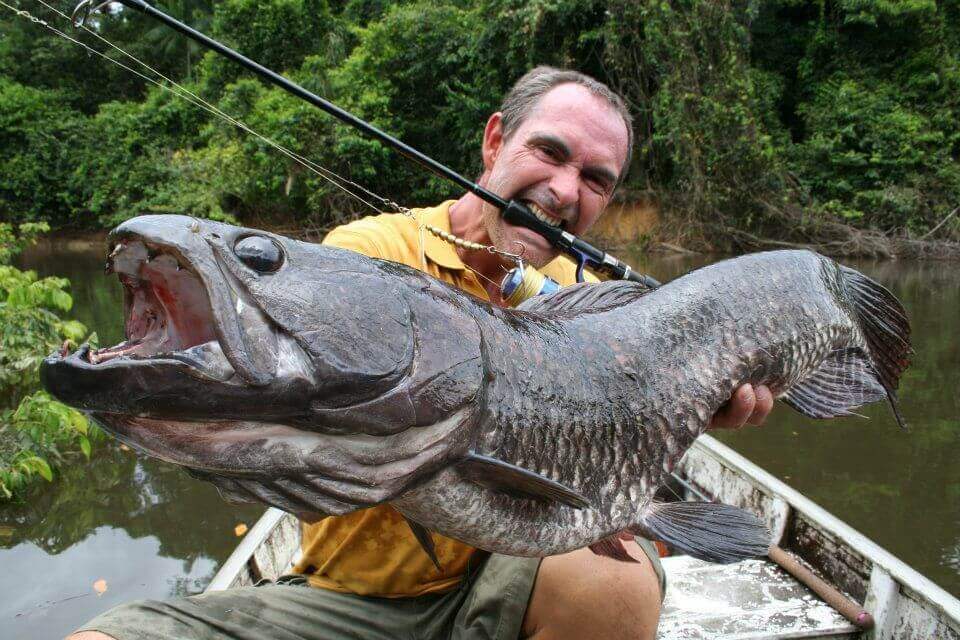
When selecting a fishing rod for traira (Hoplias malabaricus) fishing, there are a few factors to consider, such as the fishing technique, the size of the fish you are targeting, and your personal preferences.
Here are some details to keep in mind when choosing a fishing rod for traira:
- Rod Power and Action: Traira are powerful fish that can put up a strong fight, so it’s recommended to use medium to heavy power rods. The power of the rod refers to its ability to handle heavier loads, while the action refers to how the rod bends and flexes. A fast or extra-fast action rod is often preferred for traira fishing as it provides better sensitivity and quick hook-setting capabilities.
- Length of the Rod: The length of the rod is another important consideration. A general recommendation for traira fishing is a rod length between 6 and 7 feet (1.8 to 2.1 meters). A longer rod can provide better casting distance and control, while a shorter rod offers more maneuverability in tight spaces.
- Rod Material: Fishing rods can be made of various materials, including fiberglass, graphite, or a combination of both. Graphite rods are known for their sensitivity and lightness, which can be advantageous when detecting subtle strikes. Fiberglass rods, on the other hand, offer durability and more forgiving action, which can be useful when battling strong fish like traira.
- Handle and Grip: Consider the type of handle and grip that suits your fishing style and personal comfort. Cork and EVA foam handles are popular choices, providing good grip and comfort for extended fishing sessions.
- Line Weight and Lure Weight: Ensure that the rod is compatible with the line weight and lure weight you intend to use for traira fishing. The rod’s specifications should indicate the recommended line weight and lure weight range it can handle effectively.
- Quality and Brand: Opt for a reputable fishing rod brand known for producing high-quality rods that can withstand the demands of traira fishing. Quality rods tend to have better components, stronger construction, and superior performance.
It’s always a good idea to consult local anglers or tackle shops in your area for specific rod recommendations based on the fishing conditions and size of traira in your region. They can provide valuable insights and help you choose the best rod that matches your fishing preferences and budget.
Here are some examples of fishing rods suitable for traira (Hoplias malabaricus) fishing, along with their models and specifications:
- St. Croix Mojo Bass Casting Rod:
- Model: St. Croix Mojo Bass Casting Rod (MBF).
- Length: 7 feet.
- Power: Medium-Heavy.
- Action: Fast.
- Line Weight: 10-20 pounds.
- Lure Weight: 1/4 – 1 ounce.
- Features: High-modulus graphite blank, Fuji reel seat, split-grip cork handle, strong and sensitive design.
- G. Loomis E6X Casting Rod:
- Model: G. Loomis E6X Casting Rod (E6X 843C CBR).
- Length: 7 feet.
- Power: Medium-Heavy.
- Action: Extra-Fast.
- Line Weight: 10-17 pounds.
- Lure Weight: 1/4 – 3/4 ounce.
- Features: High-performance graphite blank, Fuji reel seat, premium cork handle, excellent sensitivity and casting accuracy.
- Dobyns Fury Series Casting Rod:
- Model: Dobyns Fury Series Casting Rod (FR 734C).
- Length: 7 feet 3 inches.
- Power: Medium-Heavy.
- Action: Fast.
- Line Weight: 10-20 pounds.
- Lure Weight: 1/4 – 1 1/2 ounce.
- Features: High-modulus graphite blank, Kevlar wrapping, Fuji reel seat, AA-grade cork handle, lightweight and balanced design.
- Abu Garcia Veritas Casting Rod:
- Model: Abu Garcia Veritas Casting Rod (VRC70-6).
- Length: 7 feet.
- Power: Medium-Heavy.
- Action: Fast.
- Line Weight: 10-20 pounds.
- Lure Weight: 1/4 – 1 ounce.
- Features: 30-ton graphite blank, Abu Garcia’s Spiral Carbon Core Construction, Fuji reel seat, EVA grip handles, lightweight and responsive performance.
- Ugly Stik Elite Casting Rod:
- Model: Ugly Stik Elite Casting Rod (USECA661MH).
- Length: 6 feet 6 inches.
- Power: Medium-Heavy.
- Action: Fast.
- Line Weight: 10-20 pounds.
- Lure Weight: 1/4 – 3/4 ounce.
- Features: Ugly Tech graphite and fiberglass construction, Clear Tip design, Ugly Tuff guides, comfortable cork handle, durable and versatile design.
Please note that the specific models and specifications mentioned above are examples, and there are many other brands and models available in the market. It’s always recommended to try out different rods and consult with local anglers or fishing experts to find the rod that best suits your fishing style, budget, and the specific conditions of your traira fishing location.
Dishes
Traira (Hoplias malabaricus) is a popular fish in Brazilian cuisine, particularly in the Amazon region. It is known for its firm and flavorful meat.
Here are a few traditional dishes that feature traira as the main ingredient:
- Traira Assada (Roasted Traira). The traira is marinated with a mixture of herbs, spices, and lemon juice, then roasted to perfection. It is often served with rice, vegetables, and a side of vinaigrette sauce.
- Traira Frita (Fried Traira). The traira is coated in seasoned flour or breadcrumbs and deep-fried until crispy. It is typically served with cassava fries, rice, and a squeeze of fresh lime juice.
- Moqueca de Traira. This is a flavorful fish stew made with traira fillets, coconut milk, tomatoes, onions, garlic, peppers, and cilantro. The stew is simmered slowly, allowing the flavors to meld together. It is traditionally served with white rice and pirão (a creamy sauce made with fish broth and manioc flour).
- Escabeche de Traira. This dish involves marinating cooked traira fillets in a tangy sauce made with vinegar, onions, garlic, bay leaves, and spices. It is typically served cold or at room temperature and makes a delicious appetizer or side dish.
- Traira Recheada (Stuffed Traira). The traira is gutted and stuffed with a flavorful mixture of breadcrumbs, herbs, garlic, onions, and spices. It is then baked or grilled until the fish is cooked through and the stuffing is golden and crispy.
- Traira ao Tucupi. This is a traditional dish from the Amazon region. The traira is cooked in tucupi, a yellow sauce made from fermented manioc root, and served with jambu leaves (a leafy green with a unique numbing sensation) and rice. It is a popular dish during festivals and celebrations in the region.
These are just a few examples of the dishes that feature traira. The preparation and seasoning can vary based on regional preferences and personal taste. If you have access to fresh traira, you can explore these recipes or get creative with your own culinary ideas to make the most of this delicious fish.

